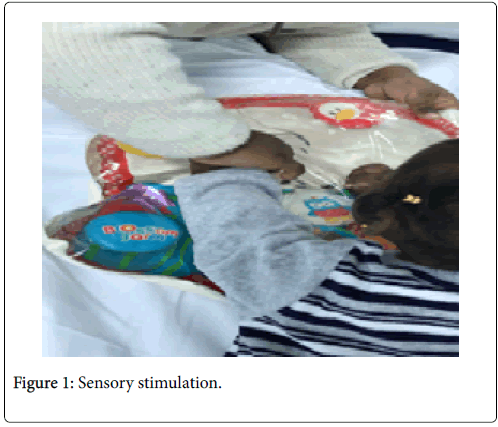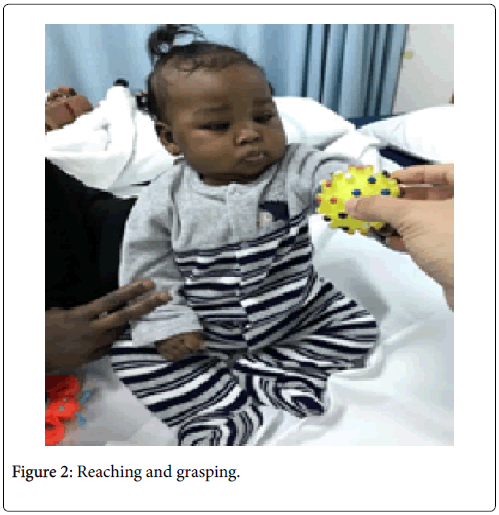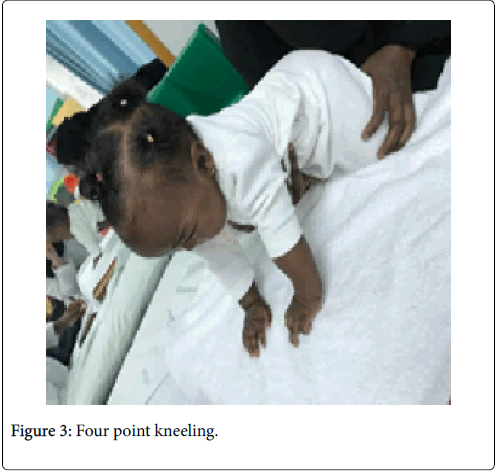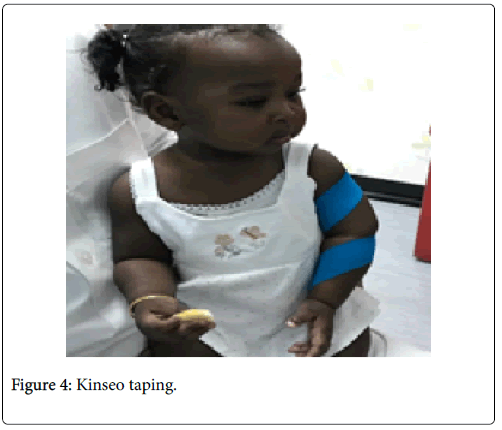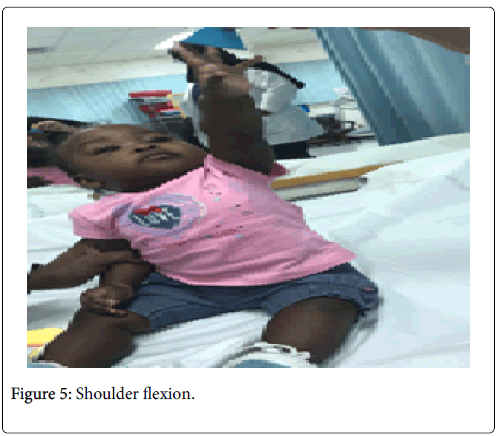Case Report, J Physiother Rehabil Vol: 2 Issue: 2
Physical Therapy Protocol for the Management of Obstetric Brachial Plexus Palsy
Samah Saud Alharbi*
King Faisal Specialist Hospital & Research Center, Riyadh 11211, 3354, MBC 45, Saudi Arabia
*Corresponding Author : Samah Saud Alharbi
King Faisal Specialist Hospital & Research Center, Riyadh 11211, 3354, MBC 45, Saudi Arabia,
Tel: 00966114647272-32977; 0096654134520
E-mail: asamah@kfshrc.edu.sa
Received: 24-10-2018 Accepted: 8-11-2018 Published: 15-11-2018
Citation: Alharbi SS (2018) Physical Therapy Protocol for the Management of Obstetric Brachial Plexus Palsy. J Physiother Rehabil 2:2.
Abstract
Background: There are 125 patients undergoing brachial plexus exploration and bilateral sural nerve graft at King Faisal Specialist Hospital and Research Center between 2005-2015. 80% of them needs extensive physical therapy post-surgery, which is proven to enhance the full recovery of the arm function, according to the evidence based studies.
Study design: The case study was used to high light the role of physical therapy in the treatment of brachial plexus palsy post-surgery.
Case description: 4 Months old Saudi girl had been diagnosed with left C5-C6 brachial plexus injury (Narakas 1) patient underwent exploration and bilateral nerve grafting on the age of three months old, placed in baby holder for three weeks. Then the pediatric orthopedic surgon referred her to the physical therapy clinic for Obstetric Brachial Plexus Palsy (OBPP) protocol.
Management and outcomes: The patient received one session per month included: positioning and instructions to handle the patient in proper way, passive range of motion, active range of motion and strengthening exercises. Sensory stimulation and certain program to facilitate normal posture and motor development. At the second visit the patient started to improve gradually in Range of Motion (ROM) and Muscle Power (MP). After six months of treatment, the patient able to pull herself to stand alone, cruising independent, and crawling with left hand opened on the floor.
Discussion:This case study showed that theearly physical therapy interventionpost – surgery for brachial plexus injury upper region can improve/cure the patient condition.
Introduction
OBPP is an injury to the portion or all roots of the brachial plexus (C5, C6, C7, C8, T1 roots) during vaginal delivery [1]. The incidence around 1 per 1000 live births with permanent disabilities reaching 20-30% of the cases [2]. The most common risk factor for the OBPP was shoulder dystocia [3]. The role of physical therapy for such conditions became more familiar and the result of physical therapy is often satisfactory and lead to improve /cure the problem [4,5].
Study design
The case study was used to highlight the role of physical therapy in the treatment of OBPP, in order to help the other therapist to follow the same treatment program.
Case Description
Patient history
Four months old Saudi girl arrived to the physical therapy clinic from orthopedic clinic diagnosed with left C5-C6 OBPP (Narakas 1) patient underwent exploration and bilateral nerve grafting on the age of three months old, placed in baby holder for three weeks. Then referred to the physical therapy clinic for OBPP protocol.
At the beginning of treatment, I worked with the parents to set both the short-term and long – term goals. When I referred to a patient’s long-term goals I meant to set achievable goals, and I explained to the parents the time it will take to achieve the short term goals will be less than what will be needed to achieve the long-term goals. Initially, for the long-term goals. The parents wanted the baby to be able to reach the functional level. As for her short-term goals, to maintain range of motion, prevent muscle atrophy and increase sensation by 80%.
Assessment/ findings
(MP), (ROM) and sensation (Table 1) where patient was not able to move shoulder and elbow: Toronto scale 0-7 was used for muscle power and use Narakas sensory grading system S0-S3.
| 4 Months | 5 Months | 6 Months | 7 Months | 8 Months | 10 Months | 12 Months | |
|---|---|---|---|---|---|---|---|
| ROM | |||||||
| shoulder flexion | 0 | 30 | 60 | 80 | 80 | 120 | 160 |
| Abduction | 0 | 0 | 20 | 40 | 40 | 95 | 120 |
| Adduction | Normal | Normal | Normal | Normal | Normal | Normal | Normal |
| External rotation | 0 | 0 | 0 | 0 | 0 | 0 | 0 |
| Internal rotation | 90 | 90 | 90 | 90 | 90 | 90 | 90 |
| Elbow flexion | 0 | 10 | 30 | 50 | 50 | 120 | 130 |
| Supination | 0 | 0 | 10 | 30 | 30 | 60 | 80 |
| Pronation | 90 | 90 | 90 | 90 | 90 | 90 | 90 |
| Hand Function | Normal | Normal | Normal | Normal | Normal | Normal | Normal |
| MP | |||||||
| shoulder flexion | 0/7 | 2/7 | 5/7 | 5/7 | 5/7 | 6/7 | 6/7 |
| Abduction | 0/7 | 0/7 | 4/7 | 5/7 | 5/7 | 6/7 | 6/7 |
| Adduction | 7/7 | 7/7 | 7/7 | 7/7 | 7/7 | 7/7 | 7/7 |
| External rotation | 0/7 | 0/7 | 0/7 | 0/7 | 0/7 | 0/7 | 0/7 |
| Internal rotation | 7/7 | 7/7 | 7/7 | 7/7 | 7/7 | 7/7 | 7/7 |
| Elbow flexion | 0/7 | 2/7 | 2/7 | 4/7 | 4/7 | 6/7 | 6/7 |
| Supination | 0/7 | 0/7 | 4/7 | 5/7 | 5/7 | 6/7 | 6/7 |
| Pronation | 7/7 | 7/7 | 7/7 | 7/7 | 7/7 | 7/7 | 7/7 |
| Hand function |
7/7 | 7/7 | 7/7 | 7/7 | 7/7 | 7/7 | 7/7 |
| Sensation | |||||||
| Shoulder | S0 | S1 | S2 | S2 | S2 | S3 | S3 |
| Elbow | S0 | S0 | S1 | S2 | S2 | S3 | S3 |
| Hand | S3 | S3 | S3 | S3 | S3 | S3 | S3 |
Table 1: ROM, MP and sensation progression of the patient case.
Intervention
Initial treatment plan (Stage 1)
• Start with positioning and handling of patient
• Patient referred to occupational therapy for splinting to put patient arm in abduction external rotation and forearm supination.
• Mother was informed to follow the instructions: hold the baby’s arm across baby’s abdomen during feeding, also dressing the baby start with affected arm and undress start with sound arm. Arm should be supported while carrying the baby. And to do passive ROM exercises X10 repetitions (make it as daily routine, after each changing diaper).
Outcome
Findings: ROM, MP, and sensation (Table 1).
Stage 2 Plan of care at the age of five months:
1. The same home program.
2. Encourage baby to roll symmetrically both sides, and encourage weight bearing on affected side.
3. Sensory stimulation program by using different texture (using sensory bag that contain different texture from prone position (Figure 1).
Findings: At the age of six months, she started to sit with propping on right hand. Able to roll to both side alone, also from supine to prone with full weight bearing and partial weight bearing on left.
Stage 3 Plan of care:
1. The same home program, added strengthening exercises through reaching and grasping activities (Figure 2).
2. Encourage bimanual activities. Ball therapy, facilitate normal posture and motor development, continue with sensory stimulation program: tactile stimulation and sensory bag from sitting.
3. Constraint induced movement therapy.
Findings: at the age of seven months: she started to sit alone with a good balance, able to grasp and reaching object with pronated forearm.
Stage 4 Plan of care:
1. The same home program, added roll the ball/ moving cars, stacking rings. Four-point kneeling exercise (Figure 3).
2. Ball activities (sitting, lying on tummy). encourage bimanual activities focusing put the forearm in functional position.
3. Sensory stimulation place objects inside the water or sand or rice and ask baby to pick it up.
Findings: at the age of eight months: Patient started to use left hand during playing, able to sit independently from supine position, using creeping for her transition. ROM, MP and sensation were the same.
Stage 5 Plan of care:
1. The same home program.
2. Occupational therapy started, used pronation strap in order to encourage supination movement using during the day two hours on and two hours off.
Findings: at the age of ten months able to pull to stand alone, cruising independent and get crawling position with left hand opened on the floor.
Stage 6 Plan of care:
1. The same home program, added pull to sit from side way, crawling, and swimming. Hands to mouth exercise, using taping to encourage forearm supination (keep it for 3-5 days’ rest one day and repeat the process for one month (Figure 4).
Findings: at the age of twelve months, the mother reported that the baby is improved a lot and using left hand.
Stage seven Plan of care:
1. The same home program.
2. Drawing on the board, stick the stickers on the wall with different levels and climbing the ladder (Figure 5).
3. Continue kinseo-taping for forearm supination.
New goals:
Continue to pursue long-term goal.
Discussion
Based on my results, I strongly supported physical therapy intervention for the brachial plexus injury upper region post-surgery, which can cure/improve the muscle power, range of motion, sensation, and functional activities. Additionally, the compliance of the patient’s parent s with the given home exercises program is very essential to improve the patient case.
Conclusion
The early physical therapy assessment and intervention can improve the patient status.
References
- Al-Qattan MM (2004) Obstetric brachial plexus palsy: An experience from Saudi Arabia. In: Semin Plast Surg 18: 265
- Al-Mohrej OA, Mahabbat NA, Khesheaim AF, Hamdi NB (2018) Characteristics and outcomes of obstetric brachial plexus palsy in a single Saudi center: An experience of ten years. Int Orthop 18: 1-8.
- Mancuso CA, Lee SK, Dy CJ, Landers ZA, Model Z, et al. (2015) Expectations and limitations due to brachial plexus injury: A qualitative study. Hand 10: 741-749.
- Campbell SK, Palisano RJ, Orlin MN (2014) Physical Therapy for Children. Elsevier Health Sciences.
- Singh P, Kolamala K (2015) Development of a protocol for the management of Obstetric Erb's Palsy. Indian J Occup Ther 47: 1-6.
 Spanish
Spanish  Chinese
Chinese  Russian
Russian  German
German  French
French  Japanese
Japanese  Portuguese
Portuguese  Hindi
Hindi 